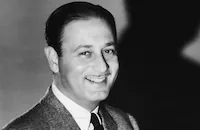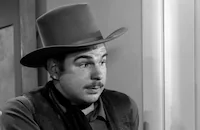Fighting Man of the Plains

Brief Synopsis
Cast & Crew
Edwin L. Marin
Randolph Scott
Bill Williams
Victor Jory
Jane Nigh
Douglas Kennedy
Film Details
Technical Specs

Synopsis
During Will Quantrill's raid on Lawrence, Kansas, in August, 1863, Jim Dancer mistakenly kills Theodore Slocum, the brother of Bert Slocum, the man who had killed Jim's own brother. The act is witnessed by Theodore's daughter Evelyn. When the Civil War ends, many of Quantrill's men become outlaws. In 1871, Bert Slocum hires the Pleasanton Detective Agency of Chicago to bring Jim in to stand trial for Theodore's death. Pleasanton agent George Cummings captures Jim and plans to turn him in to his firm's Kansas City office. As they are crossing a swollen river, Cummings is handcuffing Jim when the ferry on which they are traveling rolls suddenly and the key falls overboard. Cummings is then hit by a rearing horse and he and Jim, handcuffed together, fall into the river. The next morning, when a stagecoach arrives at the ferry crossing, Jim and Cummings are found on the river bank by a passing stagecoach. Because Cummings is dead, Jim impersonates him and says that the body is that of his prisoner, Jim Dancer. Dave Oldham, one of the stagecoach passengers, then cuts Cummings's hand off in order to free Jim. Slocum is at the Kansas City office when Jim arrives. There Jim has the handcuffs removed and reports to manager Harry Travers, who has never met the real Cummings. When Slocum asks where Jim is, "Cummings" tells him that Jim died in a ferry boat accident and was buried at the river bank. Seven weeks later, after quitting the agency, Jim is in Lanyard, Kansas, working as a track layer on a railroad crew. Slocum is also in town representing Charles Lanyard, vice president of the Missouri, Kansas and Pacific Railroad, and welcoming cattlemen from Texas who are bringing their herds into town for shipment East. When Jim rescues Slocum's niece Evelyn, from the attentions of one of the cowhands whom he kills in a shoot-out, the citizens want him to be their new marshal, despite the fact that Slocum prefers gunfighter Johnny Tancred. At the Eldorado saloon, Jim encounters co-owners Dave Oldham and Florence Peel, who were also on the stagecoach and have guessed his true identity. Jim accepts the job as marshal and arrests three cowboys causing a ruckus at a dance. When their friends try to free them, Jim is assisted by Oldham and arrests nine more. Later, Jim finds notorious outlaw Jesse James waiting in his hotel room and tells him about his situation. Jim hopes that Jesse is not there to rob the bank and advises him that he would hate to have to face him in a shoot-out. Jesse leaves, but says he may be back some day. The town of Lanyard grows rapidly, as do the bank's assets. Slocum, who has created a homestead development company and is stringing barbed wire around the town's perimeter, has pushed through a city ordinance prohibiting cattle drives through the city and has appointed Tancred as Jim's deputy. After Tancred kills a cattleman, however, Jim fires him. Soon Lanyard comes to see Slocum as he and Slocum made a deal to share all profits that came from the town. By their agreement, Lanyard had purchased land from Slocum for the creation of the town, but Slocum has bought up much of the surrounding land. When Tancred tells Slocum that he thinks "Cummings" is Jim, Slocum decides to summon someone from the Pleasanton Agency. Clifford Bailey of Pleasanton soon arrives at the saloon, where he meets Oldham, an old friend from the 14th Missouri Cavalry. Oldham defends Jim to Bailey, and tries to convince him to do nothing to change the situation, even though Bailey knows that Jim is not Cummings. Jim thanks Oldham for his help but Oldham says that Bailey, who did not reveal Jim's true identity, made his own decision. One day, Yancey, who formerly rode with Jim and Quantrill, kills a store owner and he and his gang are arrested by Jim. Soon Lanyard is named the county seat and a new judge has been appointed to replace the former crooked judge, who now is acting as the killers' defense attorney. Yancey remembers from where he knew "Cummings" and identifies him in court as Jim Dancer, after which Jim resigns. When Evelyn, who previously was interested in him, learns Jim's true identity, she attacks him. Meanwhile, the judge sentences Yancey and his gang to be hanged. Slocum tells Tancred to free them, which he does in addition to shooting the judge, prosecutor and Oldham. Slocum then forces the former judge to try Jim for the crime and sentence him to death by hanging. However, Jim is saved at the last moment by Jesse, who, in collusion with Lanyard, has come to rob the bank. Tancred has decided to double-cross Slocum and take the bank's assets, irritating Jesse, who wanted to do the job himself. Jesse then gives Jim a gun with which he shoots Tancred. Slocum and Yancey are also shot in a gunfight with Jesse's gang. Finally, Florence, who has been in love with Jim, walks toward him.

Director

Edwin L. Marin
Cast

Randolph Scott

Bill Williams

Victor Jory

Jane Nigh

Douglas Kennedy

Joan Taylor

James Todd

Rhys Williams
Barry Kelley

Berry Kroeger

Paul Fix

James Millican
Burk Symon

Dale Robertson
Herbert Rawlinson

J. Farrell Macdonald
Harry Cheshire

James Griffith
Tony Hughes

John Hamilton
John Halloran
Cliff Clark
Anthony Jochim
James Harrison

Matt Willis
Crew
Fred Applegate
Maria Donovan
Lee Greenway
Frank Gruber
Wilton Holm
Nat Holt
Nat Holt
Harry Howard
Fred Jackman Jr.
Joe Jackman
William H. Kissel
Madison Lacey
Henry Mack
Philip Martin
William Mcclellan
Hugh Mcdowell
Joseph H. Nadel
Al Orenbach
Elaine Ramsey
Paul Sawtell
Clifford Shank
George Van Marter

Film Details
Technical Specs

Articles
Fighting Man of the Plains
Scott had settled into the role of western hero by the time he made Fighting Man of the Plains. He appeared in his first western in 1929 as an extra in The Virginian and he would give his final film performance in a western - Sam Peckinpah's Ride the High Country (1962). Fighting Man of the Plains came near the mid-point of Scott's career and was one of the only times that he played an outright killer. In the film, Scott plays a member of Quantrill's Raiders, a real life group of Confederate supporters who used guerrilla tactics during the Civil War.
The group was led by former schoolteacher William Quantrill, who was commissioned as a Confederate Captain, though he always operated outside the chain of command. Quantrill led his men in ambushes against Union patrols and supply convoys; he also conducted raids against civilians. In one such attack, on August 21, 1863, Quantrill's Raiders killed 183 men and boys in Lawrence, Kansas (a pro-Union stronghold). This infamous assault is depicted in the opening scenes of Fighting Man of the Plains. Quantrill would be killed by Union forces in 1865, but his raiders would ride on. The Younger brothers, as well as Frank and Jesse James, were all members of Quantrill's forces. After the war, they would apply his guerilla training to bank robberies.
Dale Robertson plays Jesse James in Fighting Man of the Plains. This version of the story cast James in a heroic light; he helps his old pal Dancer clean up a lawless town. Robertson had appeared in just a handful of films for Warner Bros. before Fighting Man of the Plains but his performance in the film led 20th-Century-Fox to sign him to a contract. When Robertson's portrayal of Jesse James drew rave reviews in the preview cards and fan mail, he followed up Fighting Man of the Plains with another Randolph Scott western, The Cariboo Trail (1950). Robertson's first leading role arrived with the college drama Take Care of My Little Girl (1951) in which he played opposite Jeanne Crain. Nevertheless, Robertson built his career on westerns, most of which were B-movies. Some of his more memorable entries include The Outcasts of Poker Flat (1952) with Anne Baxter and Miriam Hopkins, Devil's Canyon (1953), co-starring Virginia Mayo, and the Little Big Horn narrative Sitting Bull (1954). He occasionally ventured out of the western genre to tackle roles such as Sinbad in Son of Sinbad (1955). In the fifties, Robertson took his western persona to the small screen. He appeared in a number of TV series, most notably Tales of Wells Fargo in which Robertson starred from 1957 to 1962.
Along with its accomplished cast, Fighting Man of the Plains also had the expertise of two frequent western contributors behind it director Edwin L. Marin and writer Frank Gruber. Marin helmed seven Randolph Scott westerns, along with Tall in the Saddle (1944) which starred John Wayne and the outlaw saga The Younger Brothers (1949). Novelist and screenwriter Gruber published dozens of western stories, many of which were adapted for the big screen, including the Buffalo Bill-Wild Bill Hickok yarn Pony Express (1953) and Alan Ladd's The Big Land (1957). Gruber also became a very busy TV writer in later years; he created the series Shotgun Slade as well as Dale Robertson's Tales of Wells Fargo.
Producer: Nat Holt, Harry Howard
Director: Edwin L. Marin
Screenplay: Frank Gruber
Cinematography: Fred Jackman, Jr.
Film Editing: Philip Martin
Art Direction: George Van Marter
Music: Paul Sawtell
Cast: Randolph Scott (Jim Dancer), Bill Williams (Marshal Johnny Tancred), Victor Jory (Dave Oldham), Jane Nigh (Florence Peel), Douglas Kennedy (Kenneth Vedder), Joan Taylor (Evelyn Slocum).
C-94m.
by Stephanie Thames

Fighting Man of the Plains
Quotes
Trivia
Notes
The working title of this film was The Fighting Plainsman. In the film, Herbert Rawlinson's character is identified as a banker, although the CBCS lists him as a lawyer. The print viewed was probably from a 1950s re-issue as Dale Robertson's credit reads "And introducing Dale Robertson as Jesse James" and follows Jane Nigh's credit. The post-production cutting continuity and cast list at the end of the film place him much further down in the credits. Although this was not Robertson's first film, the credit May have been changed to capitalize on his popularity as a television Western star. Modern sources add Kermit Maynard to the cast.














